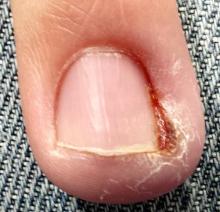Six month ago, this 36-year-old man’s left fourth finger began to bother him. He’s tried topical antibiotics (triple-antibiotic cream and mupirocin), hot soaks in solutions of Epsom salts, application of colloidal silver solution, and courses of two different oral antibiotics (cephalexin and ciprofloxacin). None have provided any relief from the pain.
The patient admits removing a hangnail from the nail in question, causing a little bleeding. Then followed the slow onset of chronic pain and swelling, which has never been severe but is painful enough to interfere with normal activities—particularly his job, which requires extensive computer time.
EXAMINATION
The medial perionychial area of his left fourth finger is modestly swollen and red and markedly tender to touch. No pus can be expressed from the area, and there are no palpable lymph nodes in either the epitrochlear or axillary locations of this arm. No lymphangiitic streaking is seen on the hand or arm. The affected area is a small section of the nail fold, where glistening, friable tissue is seen in the proximal invaginated area.
After a brief discussion of treatment alternatives, the decision is made to anesthetize the digit by means of a digital block, using 2 cc of 2% plain lidocaine. Once anesthesia is achieved, the hand is elevated above the chest and a tourniquet applied to minimize bleeding. The back of the patient’s hand is placed on his chest, then the swollen nail fold is pulled back. A 3-mm remnant of hangnail, still attached proximally, is revealed. It is removed and the area curetted. The site is cleaned and dressed, then the tourniquet is released.
Within 2 weeks, the finger is no longer swollen or painful.
Continue for Joe Monroe's discussion and take-home learning points >>

